Pros
Cons
Introduction
The HDC-HS60 will be available later this year for $699.95. The HS60 is part of a series from Panasonic that includes the HDC-SD60 and the HDC-TM55.
Design
Front
{{section_header}}{{section.name}}{{/section_header}}

Back
{{section_header}}{{section.name}}{{/section_header}}

Left
{{section_header}}{{section.name}}{{/section_header}}
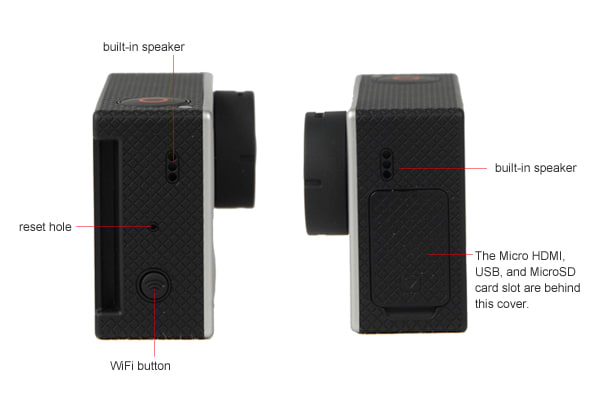
Right
{{section_header}}{{section.name}}{{/section_header}}
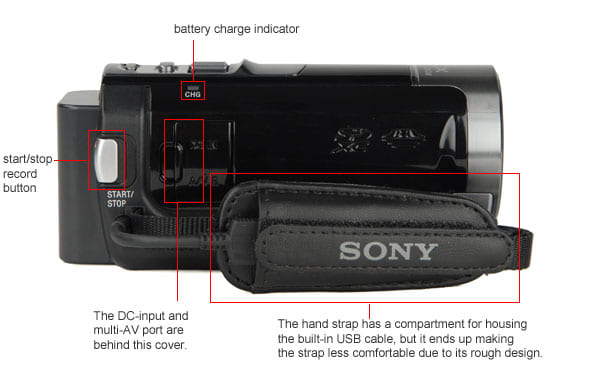
Top
{{section_header}}{{section.name}}{{/section_header}}

Bottom
{{section_header}}{{section.name}}{{/section_header}}

Size & Weight Comparison
{{section_header}}{{section.name}}{{/section_header}}
In the Box
{{section_header}}{{section.name}}{{/section_header}}

Performance
Color
{{section_header}}{{section.name}}{{/section_header}}
The HDC-HS60 performed well on our color test, with the camcorder offering improved color accuracy over last year's HDC-TM10. The HS60 measured a color error of 3.83 and a saturation level of 85.59%. If you think that saturation level is a bit low, don't you worry: the HDC-HS60 has a manual color control option that allows you to boost the saturation level (or reduce the levels) to your own liking. More on how we test color.
As you can see from the test chart image above, the HDC-HS60 captured a very pleasant image in our bright light test. The color error map (also above) shows that the camcorder was most accurate in rendering deep blues and certain red and brown tones. As we said before, the HDC-HS60 allows you to manually adjust the color depth for the recorded image. Unfortunately, this option is buried in the menu, but it is easier to access than it was on last year's Panasonics.
In addition to being able to adjust color depth, the Picture Adjust setting allows you to control color temperature (WB shift), sharpness, and basic exposure. You can see sample images taken with color depth and white balance adjustments above. Below are images taken from our bright light color test with the HDC-HS60 and its three comparison models.
The HDC-HS60 looks just as good as the other camcorders in this set, although the JVC GZ-HD300 had the best color accuracy by far. The Canon HF20 and Panasonic HDC-TM10 had slightly worse color accuracies than the HS60, but the difference wasn't that significant. In short, there's nothing bad about the color performance on any of these camcorders.
{{comparison_bars title="Color Score Comparison", attribute="Color Score", xLabel="Color Score"}}
Low Light Color
{{section_header}}{{section.name}}{{/section_header}}
The HDC-HS60 had an average performance in our low light color test. The camcorder managed a color accuracy of 5.56 and a saturation level of around 68.7%. These numbers are decent, and they do represent an improvement over the HDC-TM10, but they aren't top-notch for an HD camcorder. Still, the HDC-HS60 had one of the best low light images of the mid-range models we compared it to. More on how we test low light color.
If you look at the comparison images below, you can see that the HDC-HS60 has a much better low light image than the HDC-TM10 and JVC GZ-HD300. The HS60 does particularly better than these camcorders when it comes to saturation in low light. The Canon HF20 also has a very saturated image that looks similar to the HDC-HS60, although the Canon's image is a bit darker.
Even though the color accuracy numbers for the HS60 weren't great in low light, we are pleased with the camcorder's performance. Its saturation level was relatively high, which helped the camcorder produce strong, vivid colors in our low light test. As you'll see in the next section of this review, the HDC-HS60 also kept the noise levels down in our low light test while still retaining a fairly sharp image.
Noise
{{section_header}}{{section.name}}{{/section_header}}
The HDC-HS60 averaged 0.6275% noise in our bright light test, which is a good score. This noise percentage is slightly higher than what we saw on last year's HDC-TM10, but the difference is very minor. The important thing to note from the crops below is how much sharper the image on the HDC-HS60 is than on the Panasonic HDC-TM10. The HS60's image isn't quite as sharp as the Canon HF20, but it definitely blows the TM10 and JVC GZ-HD300 out of the water. More on how we test noise.
The Canon HF20 had the most noise in this test, but it also captured the sharpest image by far. Even with the noise percentage on the HF20 hovering close to 1%, the noise is barely detectable in bright light (most decent HD camcorders won't show a lot of noise in bright light). In low light, noise is more noticeable across the board.
{{comparison_bars title="Noise Score Comparison", attribute="Noise Score", xLabel="Noise Score"}}
Low Light Sensitivity
{{section_header}}{{section.name}}{{/section_header}}
The Panasonic HDC-HS60 didn't blow us away in our low light sensitivity test, but it did do a lot better than the competition. The camcorder needed just 15 lux of light to reach 50 IRE on our waveform monitor, which, if you're keeping score, is half as much light as the Panasonic HDC-TM10 required. This is a noted improvement from Panasonic that we are pleasantly surprised to see. Often, when a camcorder comes along with an increased pixel count we notice a dip in low light sensitivity. Thankfully, this was not the case with the HDC-HS60. More on how we test low light sensitivity.
Unlike most Panasonic camcorders, the HDC-HS60 does not include a 24p recording mode (called Digital Cinema mode by Panasonic). Panasonic strangely eliminated this feature from its whole line of 2010 mid-range HD models (the HDC-SD60 and HDC-TM55 don't have it either). Usually, a 24p frame rate gives the camcorder a better low light sensitivity and a boost in low light performance overall (such was the case with the 24p modes on the Canon HF20 and the Panasonic HDC-TM10).
{{comparison_bars title="Low Light Sensitivity Comparison", attribute="Low Light Sensitivity Score", xLabel="Low Light Sensitivity Score"}}
Low Light Noise
{{section_header}}{{section.name}}{{/section_header}}
The HDC-HS60 averaged 1.5725% noise in our low light test, which is higher than last year's HDC-TM10. The thing to look at, however, is how much sharper the HS60's low light image is compared to the competition (specifically the TM10 and the JVC GZ-HD300). Many times we'll see a camcorder that measures a very low amount of noise, but its image has almost no detail—this is the case with the Panasonic HDC-TM10 and the JVC GZ-HD300. More on how we test low light noise.
The HDC-HS60 arguably captured a sharper image than the Canon HF20 in our low light test, but it's difficult to pick a clear winner. What is obvious, though, is that the Canon HF20 had a lot more noise than the HDC-HS60, and you can even see this noise in the images above.
With its decent scores across the board, the HDC-HS60 is one of the best mid-range camcorders we've tested in low light. Its noise levels were never too high and the camcorder retained strong color depth and detail in all of our low light tests.
{{comparison_bars title="Low Light Noise Score Comparison", attribute="Low Light Noise Score", xLabel="Low Light Noise Score"}}
Low Light Color
{{section_header}}{{section.name}}{{/section_header}}
The HDC-HS60 had an average performance in our low light color test. The camcorder managed a color accuracy of 5.56 and a saturation level of around 68.7%. These numbers are decent, and they do represent an improvement over the HDC-TM10, but they aren't top-notch for an HD camcorder. Still, the HDC-HS60 had one of the best low light images of the mid-range models we compared it to. More on how we test low light color.
If you look at the comparison images below, you can see that the HDC-HS60 has a much better low light image than the HDC-TM10 and JVC GZ-HD300. The HS60 does particularly better than these camcorders when it comes to saturation in low light. The Canon HF20 also has a very saturated image that looks similar to the HDC-HS60, although the Canon's image is a bit darker.
Even though the color accuracy numbers for the HS60 weren't great in low light, we are pleased with the camcorder's performance. Its saturation level was relatively high, which helped the camcorder produce strong, vivid colors in our low light test. As you'll see in the next section of this review, the HDC-HS60 also kept the noise levels down in our low light test while still retaining a fairly sharp image.
Motion
{{section_header}}{{section.name}}{{/section_header}}
The HDC-HS60's video looked very good in our motion test, and the camcorder showed significantly better motion rendering than last year's Panasonic HDC-TM10. One shocker, however, is that Panasonic declined to include its 24p Digital Cinema mode on the HDC-HS60 (the feature is also absent on the HDC-TM55 and HDC-SD60). We're not sure why Panasonic dropped this feature—it was on all of the manufacturer's HD camcorders in 2009—but it might be that Panasonic is pushing its native 24p setting on its new flagship models (the HDC-HS700 and TM700) instead. More on how we test motion.
Video Sharpness
{{section_header}}{{section.name}}{{/section_header}}
In our testing, the HDC-HS60 measured a horizontal sharpness of 800 lw/ph and a vertical sharpness of 600 lw/ph. These scores are both very good for a mid-range HD camcorder—and it represents a big improvement over last year's HDC-TM10 and other mid-range models from Panasonic. We're happy to see this sharpness improvement from Panasonic, and it goes to show how much impact a larger sensor can have on video performance. As far as mid-range HD camcorders go, only the Canon HF20 captured a sharper image than the HDC-HS60 in our test. More on how we test video sharpness.
{{comparison_bars title="Video Sharpness Score Comparison", attribute="Video Sharpness Score", xLabel="Video Sharpness Score"}}
Testing Samples
{{section_header}}{{section.name}}{{/section_header}}
Usability
Ease of Use
{{section_header}}{{section.name}}{{/section_header}}
The HDC-HS60 is just as easy to use as last year's mid-range camcorders from Panasonic. The presence of Panasonic's Intelligent Auto (iA) controls, along with the simple-to-use touchscreen interface, make the HDC-HS60 an ideal camcorder for beginners. That's not to say the camcorder doesn't have its faults, however. Many of the icons on the camcorder's Function Menu are difficult to understand, which can be a problem for first-time users. The camcorder does come with an extensive instruction manual, but we found it was often lacking important information and its layout made certain sections difficult to understand.
The menu system on the HDC-HS60 is simple, but it can take a long time to navigate through the various menu screens because you must do so one page at a time. This setup can definitely become frustrating once you start to get to know the camcorder extremely well. The menu does have an information box that you can select to get more info about certain menu options. While we love having this 'tool tip' feature, we don't really like the scrolling text system that Panasonic put into place. Sometimes you have to wait for up to 20 seconds as information scrolls across the screen—at a very slow pace—before you are actually able to read the entire tool tip. This is a simple flaw that Panasonic could easily correct on future models.
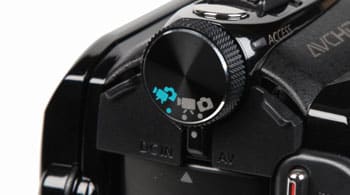
Auto Mode is confusingly called Dual Shot mode
Auto Mode
{{section_header}}{{section.name}}{{/section_header}}
We're happy to see that Panasonic kept around its Intelligent Auto (iA) control system on the HDC-HS60. With the iA controls you can run the camcorder in a fully automated mode, as well as implement features like AF/AE tracking, face detection, and intelligent contrast control. Panasonic didn't make too many improvements with these controls, but it did add face recognition and name display options to the camcorder's face detection setting.
The iA controls are designed well to work with the camcorder's touchscreen interface. The AF/AE tracking requires a simple tap of the screen for the camcorder to track your subject (AF/AE will focus and expose the tracked subject as it moves throughout the frame). The camcorder can maintain a track on a subject that leaves the frame, but only if the subject isn't gone for very long.
We're happy with all of the HDC-HS60's automatic controls with the exception of white balance. The camcorder often had trouble white balancing properly when we shot under halogen bulbs. Outdoors the auto white balance appeared to work fine, but we'd recommend using a manual white balance when you shoot indoors if you can.
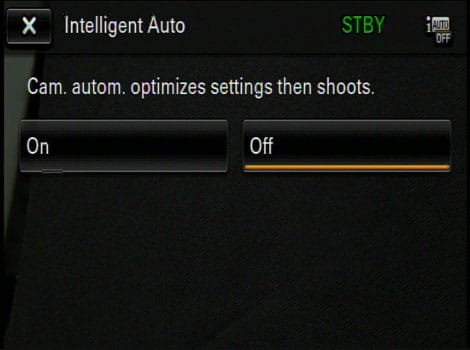
The iAuto mode button is difficult to find, but when you do find it the option for turning on the mode looks like this.
Other Auto Features
Handling
{{section_header}}{{section.name}}{{/section_header}}
The design of the HDC-HS60 is very similar to Panasonic's mid-range models from last year. The camcorder isn't too big and it isn't too small, and it should appeal to those who like a traditional camcorder design. We weren't impressed with the way the HDC-HS60 felt in our hand because of its bulky right-side grip. This is entirely due to the fact that there's a 120GB internal hard drive located on this side, so if you are very concerned about comfort you may want to check out the HS60's flash memory siblings (the HDC-SD60 or the HDC-TM55).

Panasonic clearly doesn't use the best hand straps on its mid-range models, and we were a bit disappointed with the flimsy strap featured on the HS60. Still, the camcorder's compact body made it easy to get a good grip, and it's lightweight design made for a decent handling experience. As for the buttons located on the HS60... well, most of them are fine and there really aren't too many of them. The only ones that aren't great are the 'membrane buttons' located on the base of the LCD panel.

The HDC-HS60's LCD touchscreen has its problems (don't they all?), but it does work well with some of the camcorder's auto controls—like AF/AE tracking. We didn't think the touchscreen was all that great for setting manual controls, particularly because there is no alternative method (like a dial or lens ring) for making adjustments.

Overall, the HDC-HS60 is a camcorder that offers simple handling and should appeal to novice users. If you are someone that hates touchscreens or wants the precise control of a lens ring or dial, you should check out some of the higher-end models on the market.

These dedicated buttons give you quick access to aperture and shutter speed controls.
Portability
{{section_header}}{{section.name}}{{/section_header}}
The HDC-HS60 is a bit larger and heavier than last year's HDC-TM10, but most of its increased proportions stem from its 120GB internal hard drive. This hard drive really bulks up the right side of the camcorder, although the HDC-HS60 is still fairly small. The camcorder is probably too large to fit in most pockets, although it would work in a large coat pocket or a decently-sized purse. The fact that the camcorder has a 120GB internal hard drive does increase its portability, as you don't have to worry about packing extra memory cards when you go on vacation.
Looking at the table below you'll see that the HDC-HS60 is about the same size as the JVC GZ HD300, slightly larger than the HDC-TM10, and significantly smaller than the Canon HF20.
Battery Life
{{section_header}}{{section.name}}{{/section_header}}
The HDC-HS60 (with its provided battery pack) lasted for 103 minutes in our battery test. This is an average score for a mid-range camcorder and you can see how the competition stacked up by checking out the chart below. The best thing about the new design of the HDC-HS60 (compared to last year's Panasonic HDC-TM10) is that the battery compartment is open-ended. This means you can easily load the camcorder up with a larger, longer-lasting battery pack. More on how we test battery life.

{{comparison_bars title="Battery Life Comparison", attribute="Battery Life Score", xLabel="minutes"}}
LCD
{{section_header}}{{section.name}}{{/section_header}}
The Panasonic HDC-HS60 has the same basic LCD as last year's HDC-TM10. The screen is 2.7 inches in size and has a roughly 230,000-pixel resolution. Neither of these specs are particularly impressive, but compared to the other mid-range HD camcorders the HS60's LCD is actually quite good. Most manufacturers made the jump to larger LCDs on their flagship models in 2010... When will they start to push larger screens for mid-range models?
The LCD on the HS60 uses touchscreen technology and the screen functions in the same manner as last year's Panasonic camcorders. (Last year was the first year Panasonic introduced touchscreen LCDs.) There are also a few buttons on the base of the LCD panel—start/stop record, zoom buttons, menu, video light, and a delete button (for deleting clips during playback).
The HDC-HS60 does not have an electronic viewfinder, which is the norm for a mid-range model. The LCD has a number of display options, including a Power LCD setting that allows you to raise or lower the backlight illumination. You can also change the brightness and color settings for the LCD.
Stabilization
{{section_header}}{{section.name}}{{/section_header}}
The HDC-HS60 is equipped with optical image stabilization (OIS) as well as an additional active stabilization mode that is supposed to help stabilize footage in a high-shake situation. In our testing, we found the active stabilization mode did work better than the camcorder's regular OIS, although the difference wasn't that dramatic. At best, the HDC-HS60 reduced 39% of the shake in our low shake test and 41% of the shake in our high shake test. With regular OIS engaged, the camcorder improved stabilization by 35% in our low shake test and 34% in our high shake test. More on how we test stabilization.
This is a decent performance by the HDC-HS60, but we've gotten far superior stabilization results from Sony's high-end camcorders like the HDR-CX500V and HDR-XR520V. The Panasonic HDC-TM10—which has the same OIS and active mode system as the HDC-HS60—also did a bit better than the HS60 in this test. The different shape and size of the two camcorders is the likely reason behind this discrepancy.
Even though Panasonic didn't improve the OIS on the HDC-HS60, we're not really disappointed by these results. The camcorder did a decent job for a mid-range model and we like the fact that Panasonic uses OIS instead of a digital stabilization system (which can degrade image quality). The JVC GZ-HD300 is the only model in this set that uses digital stabilization instead of optical stabilization.
Manual Focus
{{section_header}}{{section.name}}{{/section_header}}
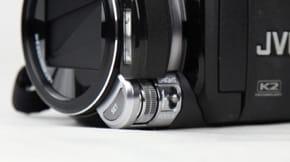
The adjustment dial makes accurate focus adjustments easy.
Manual Exposure
{{section_header}}{{section.name}}{{/section_header}}
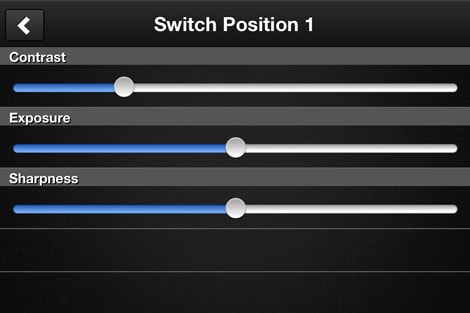
The manual exposure controls are only found on the Contour app, not on the camcorder itself.
Miscellaneous Controls
{{section_header}}{{section.name}}{{/section_header}}
Soft Skin Mode
This mode will soften skin tones, although it does so very subtly.
Digital Cinema Color
Allows the camcorder to record using the xvYCC expanded color gamut. You'll only notice a difference if you view the video on an xvYCC compatible television.
Intelligent Contrast
Corrects exposure levels on images with both dark and overexposed portions.
Picture Adjust
This submenu has options for adjusting sharpness, color, brightness (exposure) and WB adjust. The menu is buried so it takes a little while to get to it, but the options located here can be very useful.
Guide Lines
There are three options for displaying guide lines on the HDC-HS60: as three horizontal lines, a 9-sector grid, or a 60-sector grid. The lines assist with framing only and they won't end up in your recorded footage (although you can turn them on during playback if you wish).
Tele Macro
Allows the camcorder to focus on extremely close-up subjects. The focal distance is roughly 1cm to 1m, and the camcorder zooms in fully when the feature is engaged.
Audio Controls
{{section_header}}{{section.name}}{{/section_header}}
The HDC-HS60 does not have any inputs for an external microphone, but the camcorder itself has a decent amount of audio controls. You can adjust the audio levels manually for the built-in stereo microphone (see the screen capture below), and you can turn on a zoom mic feature (the microphone's recording will focus on whatever subject the lens is zoomed into). The HDC-HS60 also features a new wind noise canceler feature that is said to be much improved over Panasonic's previous wind cut option.
This new wind noise canceler uses noise reduction technology—similar to what you'd find in noise canceler headphones—rather than simply using a high-pass filter to cut out the sound of the rustling wind, which is what most camcorders use.
Editing
{{section_header}}{{section.name}}{{/section_header}}
The HDC-HS60 ships with HD Writer AE version 2.0 editing software. This is the same software that came with last year's Panasonic camcorders, but it has been updated to a new version. The camcorder also has a few internal editing options that allow you to divide or copy clips in-camera. For an overview of the software that ships with this and other camcorders, see our article: Video Editing Software For Your Camcorder{{product.brand.name}}-Included-Software.htm.
Features
Compression
{{section_header}}{{section.name}}{{/section_header}}
The Panasonic HDC-HS60 uses the same AVCHD compliant compression system as last year's HD models from Panasonic. This compression system, which uses the MPEG4-AVC/H.264 codec is a standard in the consumer camcorder industry for high definition camcorders.
We must point out that the HDC-HS60 tops out with a bitrate of 17Mbps for recording video. The maximum bitrate AVCHD can handle is 24Mbps, and all of the other major manufacturers offer this recording bitrate—including Sony, who implemented a 24Mbps bitrate on its new camcorders in 2010. We're somewhat surprised that Panasonic did not make the jump to 24Mbps this year, although the company does offer a 24Mbps bitrate on some of its professional camcorders. The HDC-HS60 has four quality settings for recording video, but it does not have any options for recording in standard definition. Read more about the advantages and disadvantages of various high definition compression types.
Media
{{section_header}}{{section.name}}{{/section_header}}
With the Panasonic HDC-HS60, you have the option of storing video on the camcorder's 120GB internal hard drive, or to memory cards via its SD/SDHC card slot. The memory card slot is also compatible with SDXC cards up to 64GB in size, although SDXC cards aren't widely available yet. The 120GB internal hard drive will allow you to store lots of video right on the camcorder (close to 16 hours at the highest quality), but internal hard drives do have their problems as well.
The table below lists the approximate record times (according to Panasonic) for the HDC-HS60. The record times vary depending on what media and quality settings are used. The HDC-HS60 does not allow for continual recording from the camcorder's internal hard drive to an inserted memory card. This feature, often called relay record, only works with the Panasonic HDC-TM55 (continually recording from internal memory and then to a memory card). Read more about the advantages and disadvantages of various media types.

Slow Motion Modes
Still Features
{{section_header}}{{section.name}}{{/section_header}}
Panasonic improved the still image capabilities on the HDC-HS60 compared to last year's HDC-TM10, but the HS60 still isn't close to being a good camcorder for snapping photos. The maximum native resolution on the HDC-HS60 is 1920 x 1080 (around 2.1 megapixels), which is far worse than the native resolution of most dedicated digital cameras. Now, the HS60 does have many other photo size options—like its 5-megapixel 2592 x 1944 resolution—but every photo taken by the camcorder that is over 2 megapixels is interpolated.
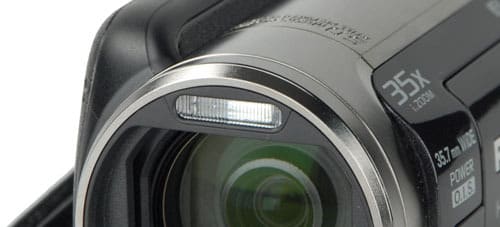
Most of the manual controls available in video mode are available in photo mode too, but there are a few extra features that only work with still images. There's a Night Portrait scene mode, a 2 or 10-second self timer, and a built-in flash that has a variety of settings (including red-eye reduction and intensity options). There's also a smile shutter feature that will automatically snap a still photo when the camcorder detects a smiling face within the frame (only works during video recording). Unfortunately, there is no way to adjust the sensitivity for detecting smiles on the camcorder, so be prepared for this feature only to work with big, exaggerated smiles.
The HDC-HS60 did well in our still color test and the camcorder registered a very similar color error score to what it earned in our bright light video color test. The HS60 managed a color error of 3.97 and a saturation level of 104%. This saturation level is quite a bit higher than what the camcorder scored in our video testing.
The HDC-HS60 had more noise in its still photos than we would have liked. We measured the noise at roughly 0.92%, which is more noise than the camcorder had in our bright light video test. This is also double the amount of noise that the HDC-TM10 measured, although the two camcorders have completely different still image capabilities.
Since the HDC-HS60 has a higher pixel count (and a larger sensor) than last year's HDC-TM10 from Panasonic, it shouldn't be a surprise that it did a lot better in this test. The HS60 managed a horizontal sharpness of 1311 lw/ph with 26.2% oversharpening and a vertical sharpness of 1067 with 7% oversharpening. These are decent scores for a camcorder that takes native 2-megapixel still photos. Still, you are likely to get much better photos from any cheap digital camera—most of which are capable of taking 8-megapixel still photos or higher.
Lens & Imaging System
{{section_header}}{{section.name}}{{/section_header}}

The HDC-HS60 has a larger image sensor, larger lens, and higher effective pixel count than Panasonic's mid-range HD models from 2009. This larger image sensor helps give the HS60 much better performance in a number of categories over last year's HDC-TM10 from Panasonic. The larger lens also gives the HDC-HS60 a very wide angle for a mid-range camcorder. The lens has an automatic lens cover that opens and closes when you power the camcorder on and off.
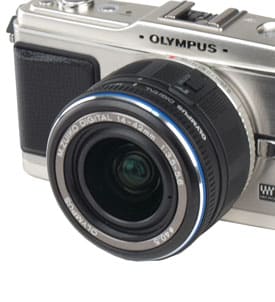
LCD
{{section_header}}{{section.name}}{{/section_header}}
The Panasonic HDC-HS60 has the same basic LCD as last year's HDC-TM10. The screen is 2.7 inches in size and has a roughly 230,000-pixel resolution. Neither of these specs are particularly impressive, but compared to the other mid-range HD camcorders the HS60's LCD is actually quite good. Most manufacturers made the jump to larger LCDs on their flagship models in 2010... When will they start to push larger screens for mid-range models?
The LCD on the HS60 uses touchscreen technology and the screen functions in the same manner as last year's Panasonic camcorders. (Last year was the first year Panasonic introduced touchscreen LCDs.) There are also a few buttons on the base of the LCD panel—start/stop record, zoom buttons, menu, video light, and a delete button (for deleting clips during playback).
The HDC-HS60 does not have an electronic viewfinder, which is the norm for a mid-range model. The LCD has a number of display options, including a Power LCD setting that allows you to raise or lower the backlight illumination. You can also change the brightness and color settings for the LCD.
Connectivity
{{section_header}}{{section.name}}{{/section_header}}
Most of the ports on the HDC-HS60 are located on the left side of the camcorder (inside the LCD cavity). Here you'll find the HDMI, USB, and AV Multi terminals—all of which are unprotected when the LCD panel is opened. The AV Multi port is a proprietary connection that works with the dual AV and Component cable that ships with the HDC-HS60. The memory card slot is also located here, and it is protected by a flexible, hinged cover.
Swinging over to the right side of the camcorder, you'll find the DC-input. This port is covered by a thick, hard-plastic cover that offers strong protection. This dedicated DC-input is also a huge improvement over previous Panasonic models that either put the DC-input inside the battery compartment, or forced you to use a wired battery pack that connected to an AC adapter. Thank you, Panasonic!!
As with most Panasonic camcorders, the HDC-HS60 offers Viera Link control. Viera Link is a Panasonic proprietary system that allows you to control compatible devices with a single remote control. So, if you have a Panasonic HDTV that is compatible with Viera Link, you can use that TV remote to control the HDC-HS60. We know this feature isn't a big deal, but we thought we should mention it nonetheless.
Media
{{section_header}}{{section.name}}{{/section_header}}
With the Panasonic HDC-HS60, you have the option of storing video on the camcorder's 120GB internal hard drive, or to memory cards via its SD/SDHC card slot. The memory card slot is also compatible with SDXC cards up to 64GB in size, although SDXC cards aren't widely available yet. The 120GB internal hard drive will allow you to store lots of video right on the camcorder (close to 16 hours at the highest quality), but internal hard drives do have their problems as well.
The table below lists the approximate record times (according to Panasonic) for the HDC-HS60. The record times vary depending on what media and quality settings are used. The HDC-HS60 does not allow for continual recording from the camcorder's internal hard drive to an inserted memory card. This feature, often called relay record, only works with the Panasonic HDC-TM55 (continually recording from internal memory and then to a memory card). Read more about the advantages and disadvantages of various media types.

Still Features
{{section_header}}{{section.name}}{{/section_header}}
Panasonic improved the still image capabilities on the HDC-HS60 compared to last year's HDC-TM10, but the HS60 still isn't close to being a good camcorder for snapping photos. The maximum native resolution on the HDC-HS60 is 1920 x 1080 (around 2.1 megapixels), which is far worse than the native resolution of most dedicated digital cameras. Now, the HS60 does have many other photo size options—like its 5-megapixel 2592 x 1944 resolution—but every photo taken by the camcorder that is over 2 megapixels is interpolated.

Most of the manual controls available in video mode are available in photo mode too, but there are a few extra features that only work with still images. There's a Night Portrait scene mode, a 2 or 10-second self timer, and a built-in flash that has a variety of settings (including red-eye reduction and intensity options). There's also a smile shutter feature that will automatically snap a still photo when the camcorder detects a smiling face within the frame (only works during video recording). Unfortunately, there is no way to adjust the sensitivity for detecting smiles on the camcorder, so be prepared for this feature only to work with big, exaggerated smiles.
The HDC-HS60 did well in our still color test and the camcorder registered a very similar color error score to what it earned in our bright light video color test. The HS60 managed a color error of 3.97 and a saturation level of 104%. This saturation level is quite a bit higher than what the camcorder scored in our video testing.
The HDC-HS60 had more noise in its still photos than we would have liked. We measured the noise at roughly 0.92%, which is more noise than the camcorder had in our bright light video test. This is also double the amount of noise that the HDC-TM10 measured, although the two camcorders have completely different still image capabilities.
Since the HDC-HS60 has a higher pixel count (and a larger sensor) than last year's HDC-TM10 from Panasonic, it shouldn't be a surprise that it did a lot better in this test. The HS60 managed a horizontal sharpness of 1311 lw/ph with 26.2% oversharpening and a vertical sharpness of 1067 with 7% oversharpening. These are decent scores for a camcorder that takes native 2-megapixel still photos. Still, you are likely to get much better photos from any cheap digital camera—most of which are capable of taking 8-megapixel still photos or higher.
Other Features
{{section_header}}{{section.name}}{{/section_header}}
Pre Record
Pre Record has become a rather common feature on consumer camcorders. It allows the camcorder to continually store three seconds of footage in an internal buffer. This way, as soon as you hit the record button you've already captured three seconds of footage (the three seconds prior to pressing record). It can be a lifesaving feature if you're shooting action-oriented sports, but Pre Record does put a strain on the battery life of your camcorder.
Auto Ground Standby (AGS)
This nifty feature will automatically stop recording if the camcorder is pointed to the ground for an extended period of time. Essentially, the camcorder thinks you forgot to hit the stop button in this scenario. The only problem with AGS is that sometimes people actually want to be filming towards the ground—so make sure you turn off this feature if that's the case.
Video Light
The video light on the HDC-HS60 can help if you're shooting in the dark, but the intensity of the light isn't very strong. You need to be very close to your subject if you want them to be fully illuminated.
Fader
Faders on the HDC-HS60 can be either white or black and they can be activated in either the main menu or the function menu.
Canon Vixia HF20 Comparison
The HDC-HS60 is a better camcorder than the HDC-TM10 hands down. It has a larger sensor, which translates into significantly better video performance, and its 120GB internal hard drive means you don't have to worry about running out of space to store your videos (for a while, at least). The HDC-HS60 also has a wider lens, bigger optical zoom, and better still image capabilities than the TM10. The only real benefits of the HDC-TM10 are the fact that it is smaller than the HS60 and that it has a more comfortable grip. The HDC-TM10 also has a 24p mode (Digital Cinema Mode), which is conspicuously absent on the HDC-HS60.
Since the HDC-TM10 is a 2009 model, it is very likely you could find a good deal for one online (around $400). Even with this price difference, however, we feel the HDC-HS60 is the better buy. Its performance is so much better than the HDC-TM10 that we feel it's a clear winner. If you don't like recording to an internal hard drive, you should check out the HDC-TM55 or HDC-SD60—both of which cost less than the HDC-HS60, but should have nearly identical performance (all three camcorders have the same lens and sensor components).
JVC GZ-HD300 Comparison
The Canon HF20 was one of the best performing mid-range camcorders we reviewed last year. In fact, the camcorder was runner-up in our award for best mid-range camcorder in 2009. That being said, the Panasonic HDC-HS60 actually did better than the Canon HF20 in most of our tests. The HS60 was the superior camcorder when it came to color accuracy, noise, and overall low light performance. The HF20 was stronger in motion and sharpness.
The Panasonic HDC-HS60 is the better camcorder here and it is also represents a better value. The HF20 is a model from last year, but it is still a fairly expensive camcorder (most online retailers list it for around $700). The only reason to go with the Canon over the Panasonic is if you are desperate to use the alternate frame rate modes offered on the HF20 (the camcorder has PF24 and PF30 frame rate options).
Before we start giving the HDC-HS60 all the accolades, we must remind you that Canon also has a new crop of mid-range models coming out in 2010. The replacement model for the Canon HF20 is the HF M30, and it should be available in April for around $699. We'll have to see what kind of performance this new crop of Canon camcorders gives us before we can say Panasonic has taken over the mid-range camcorder crown.
COMP 3
The JVC GZ-HD300 is a solid mid-range camcorder from 2009. Its sister-model, the GZ-HM200 won our award for best mid-range camcorder last year, and the GZ-HD300 put up numbers in our testing that were just as good. The HD300 is very similar to the HS60 in price, size, and specs, but in most categories the HS60 has the edge. The Panasonic has a larger zoom lens, better sharpness, more manual controls, and an internal hard drive that is 2x as large as the one featured on the GZ-HD300.
The JVC did have better color accuracy than the HDC-HS60, and we like the compact design of the GZ-HD300 (although its hand strap was terrible), but we think the HDC-HS60 is the better overall camcorder. As with the Canon HF20 and Panasonic HDC-TM10, the GZ-HD300 is a 2009 model. So, if you shop around, you can definitely find it at a reduced price (some online retailers are selling it for under $450).
Conclusion
Panasonic definitely impressed us with the improvements it made with the HDC-HS60 (MSRP $699.95). The camcorder was a much stronger performer than Panasonic's crop of mid-range models from last year, and it often matched or exceeded the performance of the Canon HF20 and JVC GZ-HD300—two of our favorite mid-range models from 2009.
That isn't to say the HDC-HS60 is the perfect mid-range HD camcorder. We were disappointed to see that Panasonic removed its Digital Cinema 24p mode from the HS60, which was featured on all Panasonic HD camcorders last year. We also weren't crazy about the HS60's touchscreen interface, particularly when we used it to set manual controls.
There are still a whole bunch of camcorders that need to pass through our labs before we can truly establish the HDC-HS60 as the best mid-range HD camcorder on the market. Canon, Sony, JVC, Samsung, and Sanyo all have intriguing new models set within the $500 - $700 price range that should offer stiff competition to the HDC-HS60. Still, this shouldn't diminish the fact that the HDC-HS60 represents a strong showing for Panasonic. Don't be surprised if this camcorder ends up winning numerous accolades come year's end.
If you like the HDC-HS60, but are interested in recording to flash memory instead of an internal hard drive, you should check out the HDC-SD60 and HDC-TM55. Both have the same lens and sensor specs as the HS60, so the only real difference between them is recording media (the SD60 is card-only, while the TM55 has 8GB of internal flash memory and a card slot).
Photo Gallery
{{photo_gallery "Front Photo", "Left Photo", "Left Open Photo", "Back Photo", "Right Photo", "Top Photo", "Bottom Photo", "Lens Photo", "Lens Photo 2", "3D Lens Photo", "Media Photo", "Easy Mode Photo", "Manual Controls Photo", "Zoom Photo", "Zoom Photo 2", "Ease of Use Photo", "Battery Photo", "LCD Photo 1", "LCD Photo 2", "EVF Photo 1", "EVF Photo 2", "Mic Photo", "Mic Photo 2", "Ports Photo 1", "Ports Photo 2", "Ports Photo 3", "Ports Photo 4", "Ports Photo 5", "Ports Photo 6", "Handling Photo 1", "Handling Photo 2", "Handling Photo 3", "Handling Photo 4", "Box Photo"}}
Meet the tester
Jeremy is the video expert of our imaging team and Reviewed.com's head of video production. Originally from Pennsylvania and upstate NY, he graduated from Bard college with a degree in film and electronic media. He has been living and working in New England since 2005.
Checking our work.
Our team is here to help you buy the best stuff and love what you own. Our writers, editors, and experts obsess over the products we cover to make sure you're confident and satisfied. Have a different opinion about something we recommend? Email us and we'll compare notes.
Shoot us an email